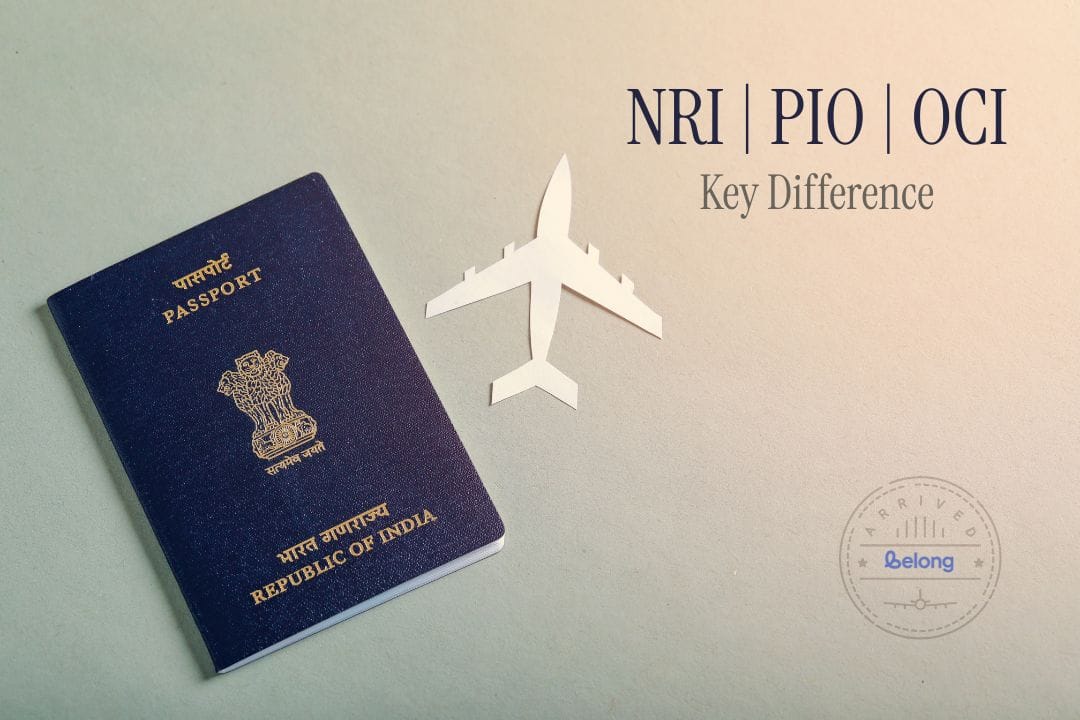Non-Resident Indians (NRIs), Person of Indian Origin (PIOs) and Overseas Citizen of India (OCIs) are all individuals who live abroad with some ties connecting them to India. While these terms may sound similar, each status has a different implication on citizenship, rights and obligations. Let’s understand the difference between NRIs, PIOs and OCIs in detail.
What is NRI, PIO and OCI? Definition and Meaning
In summary, these statuses can be defined as:
NRI Meaning - Indian citizens who live outside India for work, business, education, or other reasons without giving up their Indian citizenship.
PIO Meaning - A person whose ancestors were of Indian nationality but who is a citizen of another country. This category was discontinued in 2015. All PIO cardholders are now considered as OCIs.
OCI Meaning - Foreign nationals of Indian origin who hold an OCI card that gives them lifelong visa-free entry into India.
Who is an NRI (Non-Resident Indian)?
An NRI is an Indian passport holder who lives abroad. However, to determine your tax liability, investment eligibility and other such criteria, the following definitions apply:
As per the FEMA (Foreign Exchange Management Act) guidelines, an NRI is a person who lives outside India (except Nepal or Bhutan) for at least 182 days in a financial year (April-March).
As per the Income Tax Act, an NRI is a person who:
Stayed in India for less than 182 days in the previous financial year
Stayed in India for less than 60 days in the previous year and less than 365 days in the last 4 years
The period of 60 days is substituted by 120 days if the person earns more than ₹15 lakh from Indian sources while living abroad.
Not sure where to invest? Understand the key differences between GIFT City FD, FCNR, NRO, and NRE options.
Who is a PIO (Person of Indian Origin)?
The PIO status was officially discontinued in 2015. However, as per the Citizenship Act, a PIO was previously defined as:
A foreign citizen who once held an Indian passport
A person whose parents, grandparents, or great-grandparents were born in India or in other territories that later became a part of India (except Pakistan, Bangladesh, or any other excluded country)
A spouse of an Indian citizen or another PIO
The PIO category has been made obsolete as all PIO cards since 2016 have been converted into OCI cards.
Who is an OCI (Overseas Citizen of India)?
An OCI is a foreign national of Indian origin who holds an OCI card. An OCI is:
A person who was an Indian citizen on or after January 26, 1950.
A person who was a citizen of another country but was eligible for Indian citizenship on January 26, 1950.
A person who was a citizen of another country but belongs to a territory that became part of India after August 15, 1947.
A child, grandchild, or great-grandchild of an Indian citizen.
A foreign-origin spouse of an Indian citizen or OCI, married for at least two years.
An OCI card grants lifelong visa-free travel to India.

Key Differences Between NRIs, PIOs, and OCIs
| | NRI | PIO | OCI |
|---|---|---|---|
| Eligibility Criteria | An Indian citizen residing outside India for a combined total of at least 183 days in a financial year | Foreign national who:
| Foreign national who:
|
| Rights and Restrictions |
|
|
|
Property Ownership rules for NRIs, PIOs and OCIs
When it comes to property ownership in India, NRIs, PIOs and OCIs are all treated the same. They can acquire and own residential property in India but can not purchase agricultural land unless permitted by the government. However, inheritance of agricultural land is permitted for all the 3 categories.
Check this blog to understand who qualifies as an NRI?
Tax Implications in India for NRIs, OCIs and PIOs
As per the Income Tax Act, all global Indians, whether NRI, OCI or PIO, are divided into three categories for taxation purposes. These categories are Resident and Ordinarily Resident (ROR), Resident but Not Ordinarily Resident (RNOR) and Non-Resident (NR).
Despite your NRI, OCI, and PIO status, your tax liabilities in India will depend on the number of days you have stayed in India.
You can check your residential status using Belong’s Residential Status Calculator.
Investment and Banking for NRIs, OCIs and PIOs
NRIs, OCIs and PIOs are eligible to open NRO, NRE, and FCNR accounts in India to manage their income and savings. They can also invest in the Indian stock market either under the Portfolio Investment Scheme (PIS) using a PINS account or directly through GIFT City. However, they have been restricted from trading in currency and commodity derivatives on Indian exchanges.

Application Process for NRIs, PIOs and OCIs
Here’s are detailed step-by-step process to apply for an NRI Certificate of Registration and OCI Card. However, the PIO Card was discontinued and merged with the OCI Card in 2015.
NRI Certificate of Registration
Documents required:
Proof of overseas residence (lease agreement, utility bill, residence permit)
Duly filled application form
Recent passport-sized photographs
Valid passport.
Additional documents as specified by the Indian embassy or consulate.
Application Process:
Collect and complete the application form from the Indian embassy or consulate
Submit the form with the required documents
Pay the necessary fees
Processing Time:
Varies by location of application (While it takes 1 day in Seattle, it takes up to a week in Birmingham.
Fees:
Typically, $25 is a consular fee (INR 2150) and an additional $2 (INR 172) for the Indian Community Welfare Fund for some locations.
OCI Card
Documents required:
Proof of Indian ancestry (Indian passport/travel document of applicant or parents/grandparents)
Proof of previous Indian nationality (e.g., revenue records, domicile certificate)
Current passport with at least 6 months validity
Proof of Indian origin (birth certificate, marriage certificate if applicable)
PIO card (if converting from PIO to OCI)
Recent passport-sized photographs
Address proof
Renunciation certificate of Indian citizenship (if applicable)
Affidavit for name change (if applicable)
Application Process:
Apply through the OCI services portal or Cox and Kings Global Service Pvt. Ltd (CKGS) Application Center.
For applicants outside India, submit an application to the Indian Mission/Post in the country of citizenship or residence.
For applicants in India, submit to the Foreigners Regional Registration Offices (FRROs) based on jurisdiction
Processing Time:
New Application: 6-8 weeks
Renewal: 3-4 weeks
PIO to OCI Conversion: 3-4 weeks
Fees:
New Application:
Submitted outside India - $275 or its equivalent in local currency for each applicant
Submitted in India - INR 15,000 needs to be paid through the Demand Draft
Renewal/Conversion:
The fee is $25 or equivalent in local currency for re-issuance of OCI documents.
In case of issuance of duplicate OCI documents (for loss/damage of old documents), the fee is $100 or equivalent in local currency. In case of application is filled in India, the fee is INR 1,290
PIO Card
PIO cards have been discontinued and merged with OCI Card, as mentioned earlier. However, existing PIO Card validity has been extended, and all PIO cardholders can convert their card to OCI Card through the OCI services portal or CKGS Application Center till December 2025.
Also Read:
Recent Policy changes for NRIs, OCIs & PIOs
NRIs - The 2025-26 budget has introduced revised tax slabs under the new tax regime.
OCIs - Previously, OCI cardholders had to get a new OCI card every time they got a new passport and after they turned 20 and 50. However, with the recent changes, only those who received their OCI card before turning 20 are required to apply for a reissue after they obtain a new passport post the age of 20. As for OCI cardholders under 20 and for those who are married to Indian nationals or other OCIs, there is only a requirement to notify the government upon receiving a new passport.
PIOs - Although the PIO status has been discontinued, the validity of the PIO cards has been extended until December 31, 2025, allowing them to be used as valid travel documents along with a foreign passport.
Conclusion
Over the last few years, there have been significant changes to the rules governing global Indian statuses, with the government streamlining and outdating obsolete requirements. Whether you’re planning to invest in India, visit often, or relocate, knowing your category ensures you stay compliant with legal and financial regulations.




